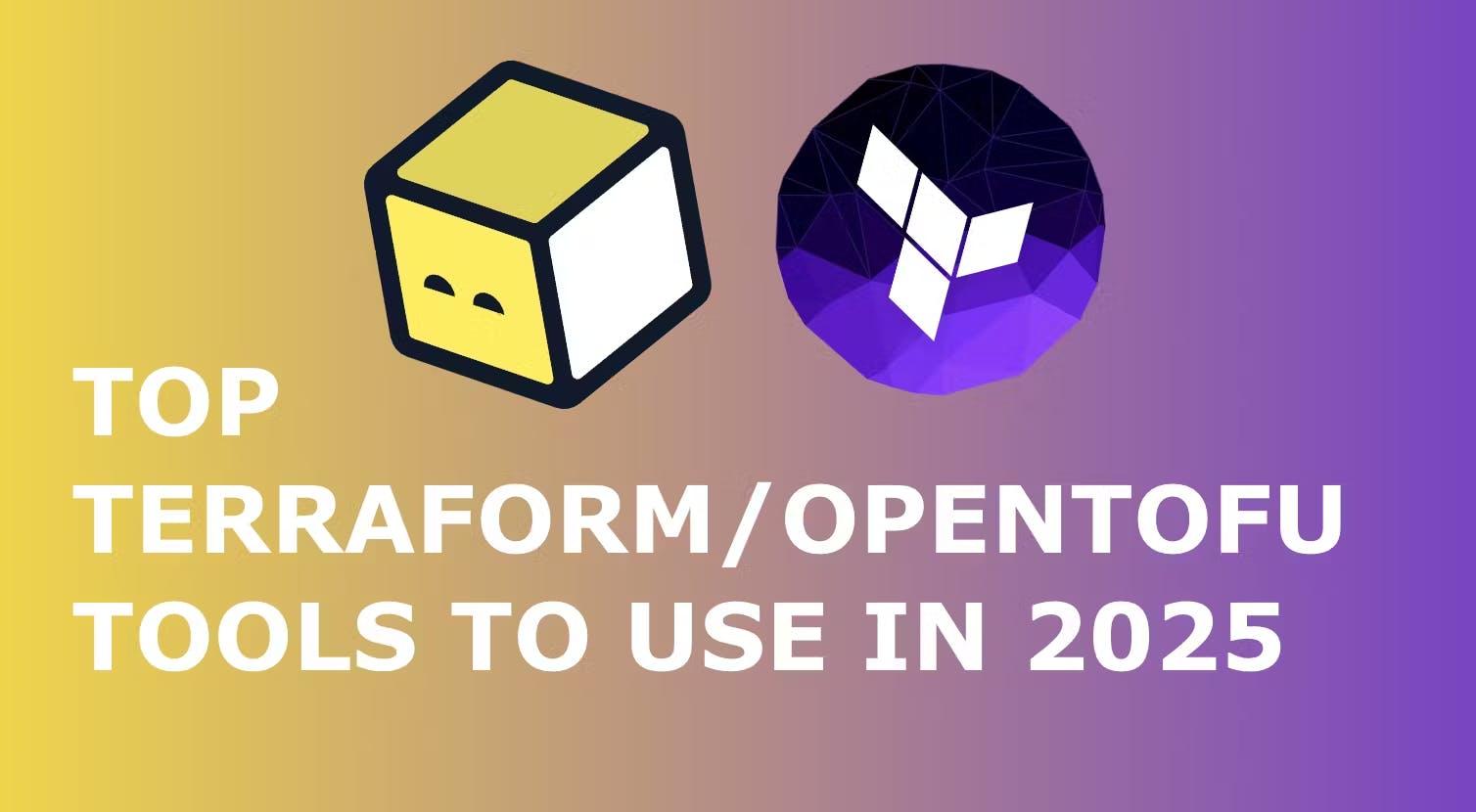Overview
Infrastructure-as-Code (IaC) has become a trusted approach for managing and provisioning infrastructure. As the field evolves, the number of IaC tools continues to grow, with frequent updates, new features, and improvements being introduced.
One of the most popular tools in this space is Terraform, a leader in the IaC ecosystem. There is a wide range of smaller tools that work alongside Terraform, adding extra features and making it even more powerful.
In this article, we’ll dive into the top most useful Terraform tools for 2025 — a curated selection of tools that stand out for their active maintenance, ongoing development, and exceptional user experience.
Pay attention, that last year, Terraform changed its license, leading the community to create a fork called OpenTofu, licensed under MPL-2.0 license. All the tools discussed in this article are fully compatible with both Terraform and OpenTofu and can be used together in mixed environments.
Ready to dive in? Let’s explore these tools and how they can supercharge your IaC workflows.
tenv
tenv is a version manager for Terraform, OpenTofu, Terragrunt, and Atmos, written in Go developed by tofuutils team. It simplifies the management of multiple tool versions. Initially developed as a successor to tfenv and tofuenv, tenv reduces the complexity of versioning, allowing developers and DevOps professionals to focus on building and deploying infrastructure without worrying about versioning issues.
While many users rely on asdf for version management, tenv is specifically tailored for the Terraform ecosystem. It offers advanced features such as HCL parsing for precise version detection and seamless management across supported tools. Besides that tenv is faster, platform-independent (thanks to its binary delivery), and prioritizes enhanced security through features like checksum and signature verification.
Key Features
- Versatile Version Management
- Supports managing multiple versions of Terraform, OpenTofu, Terragrunt, and Atmos.
- Allows easy switching between tool versions to suit different project requirements.
- Simple Installation
- Simple installation via Homebrew, Choco, Nix, Yay, Scoop, APT, Snapcraft, Docker or many more package managers and options.
- Performance & Cross-Platform Compatibility
- tenv is written in Go. It supplies an extensive list of features such as fast speed, efficiency, and uniform support for all main operating systems, including Linux, MacOS, Windows, FreeBSD, OpenBSD, and Solaris.
- Signature Verification
- Verifies downloads using
cosign and PGP (viagopenpgp ), ensuring the integrity and authenticity of tool binaries.
- Verifies downloads using
Semver 2.0.0 Compatibility- Tenv utilizes
go-version for semantic versioning andHCL parsing to extract version constraints from files likerequired_version in Terraform/OpenTofu or Terragrunt HCL files.
- Tenv utilizes
- Backwards Compatibility
- Fully supports version files used by tfenv (
.terraform-version), tofuenv (.opentofu-version), asdf (.tool-versions), and so on.
- Fully supports version files used by tfenv (
- Callable as a
Go Module
Link:
Aiac
Aiac is an Artificial Intelligence Infrastructure-as-Code Generator developed by Firefly.ai. Implemented as a library and command-line tool (CLI), Aiac leverages Large Language Models (
The CLI allows users to ask a model to generate templates for different scenarios (e.g. “get terraform for AWS EC2” or “generate GKE autopilot terraform code”). It composes an appropriate request to the selected provider, and stores the resulting code to a file, and/or prints it to standard output.
Users can define multiple “backends” targeting different LLM providers and environments using a simple configuration file. This automation significantly reduces the time and effort required for routine tasks, empowering cloud engineers to focus on high-value work.
Key Features
- Support for Multiple LLM Providers: It includes
OpenAI ,Amazon Bedrock andOllama . - Versatile Code Generation: Terraform code / CICD pipelines / OPA policies / Dockerfiles and more.
- Simplified Workflow: Allows users to generate IaC templates using simple prompts, and automatically composes requests to the selected LLM provider and saves the output to a file or prints it to standard output.
- Time-Saving Automation: Helps to reduce cloud engineers time by simple prompts that do a typical toil.
Link:
Atmos
Atmos is a cutting-edge framework designed by Cloud Posse specifically for native Terraform, enabling teams to streamline and optimize their infrastructure management processes.
With Atmos, you can break down your cloud architecture into reusable components, implemented using Terraform “root modules.” These components are seamlessly tied together using stack configurations defined in YAML, offering a clear and organized way to manage complex infrastructure setups.
This tool promotes a modular, scalable, and efficient approach to infrastructure management, making it ideal for handling even the most intricate deployments.
Key Features
Terminal UI : A polished interface that simplifies interaction with Terraform, workflows, and commands.Native Terraform Support: Streamlines orchestration, backend generation, and varfile creation while maintaining full compatibility with vanilla Terraform.Stacks: Provides a powerful abstraction layer, defined in YAML, for orchestrating and deploying components efficiently.Components: A flexible abstraction for deployable units, such as Terraform “root” modules, promoting reusability and scalability.Vendoring: Supports immutable infrastructure by pulling dependencies from remote sources for consistent deployments.Custom Commands: Extends Atmos’s capabilities by integrating custom commands into stack configurations for enhanced flexibility.Workflow Orchestration: Comprehensive lifecycle management for cloud infrastructure, from initiation to maintenance.
Link:
Terragrunt
Terragrunt is a widely used open-source tool, often referred to as a “thin wrapper” for Terraform. It enhances Terraform’s capabilities by providing additional tools to keep your configurations DRY (“Don’t Repeat Yourself”).
Developed by Gruntwork, Terragrunt simplifies managing remote states, handling multiple environments, and executing custom code before or after running Terraform. Beyond these features, it helps maintain a clean, organized codebase, making infrastructure as code more manageable and efficient.
Key Features
- DRY Principle: Adheres to the “Don’t Repeat Yourself” principle, it simplify Terraform configurations by reducing repetitive code. This approach enhances code maintainability and improves human readability.
- Remote State Management: Efficiently manages Terraform’s remote state configurations, ensuring stability and scalability. Terragrunt can automatically organize and store state files in popular storage solutions like AWS S3, Google Cloud Storage, Azure Blob Storage, or any other Terraform-supported backends.
- Dependency Handling: Simplifies the management of complex module dependencies, especially when execution order is critical.
- Multi-Module Efficiency: Optimizes workflows for large-scale deployments involving multiple modules, making it easier to handle extensive infrastructure setups.
- Environment-Specific Configuration: Supports the creation of environment-specific configurations (e.g., dev, staging, prod) using HCL (HashiCorp Configuration Language) interpolation, enabling consistent and organized environment management.
- Secrets Management: Integrates seamlessly with external secrets management tools like AWS Secrets Manager and HashiCorp Vault, ensuring sensitive data is handled securely.
- Configurable Hooks: Supports pre- and post-Terraform hooks, allowing you to execute custom scripts or commands before or after running Terraform commands for greater flexibility and automation.
Link:
Checkov
Checkov is a robust static code analysis (SCA) tool designed for Infrastructure as Code and software composition analysis (SCA). It ensures that your Terraform and other IaC configurations are secure and compliant before deployment.
Similar to Terrascan, Checkov utilizes a Python-based policy-as-code framework, differing from the Rego syntax used in OPA. Its extensive support for multiple technologies makes it a popular choice for teams managing complex cloud and containerized environments.
Key Features
- Extensive Built-in Policies:
Over 1000 built-in policies cover security and compliance best practices for major cloud providers like AWS, Azure, and Google Cloud. - Versatile Technology Support: compatible with a wide range of technologies, including: Terraform, Terraform Plan, Terraform JSON, CloudFormation, AWS SAM, Kubernetes, Helm, Kustomize, Dockerfile, Serverless framework, Ansible, Bicep, ARM, OpenTofu and more.
- Comprehensive Analysis: Uses graph-based scanning to identify misconfigurations, security vulnerabilities, and compliance issues across your IaC.
- Support of Terraform and Terraform plan analysis
- SCA Capabilities: Performs software composition analysis to detect vulnerabilities in open-source packages and container images.
Secrets Detection : Identifies exposed secrets using techniques like regular expressions, keyword matching, and entropy-based detection.- CI/CD Integration: Seamlessly integrates with CI/CD pipelines, enabling pre-deployment security checks for continuous delivery workflows.
- Provides
output in multiple formats: CLI,CycloneDX , JSON, JUnit XML, CSV, SARIF, GitHub markdown, and links to remediationguides .
Link:
Trivy
Trivy is a comprehensive, all-in-one open-source security scanner developed by aquasecurity and designed to detect vulnerabilities (CVEs), misconfigurations, secrets, and generate SBOMs across a wide range of resources, including code repositories, Terraform code, binary artifacts, container images, and Kubernetes clusters.
By integrating Terraform misconfiguration scanning into its robust ecosystem, Trivy empowers teams to proactively identify and resolve vulnerabilities, ensuring secure and compliant infrastructure deployments. Its ability to streamline security checks across various stages of development and deployment makes it an indispensable tool for modern DevOps workflows.
Key Features
- Misconfiguration Detection: Scans for security misconfigurations in Kubernetes clusters, Terraform files, Dockerfiles, and other IaC templates.
- Integrated IaC Security: Combines the capabilities of tfsec with Trivy’s broader security features, offering a unified tool for scanning Infrastructure as Code templates, including Terraform, Kubernetes manifests, and Dockerfiles.
- Pre-Deployment Validation: Ensures that Terraform configurations are secure and compliant before deployment, reducing risks in production environments.
- Vulnerability Scanning Identifies known vulnerabilities in: Container images, Filesystems, Repositories, Cloud services like AWS S3 and Lambda.
- Cloud Security Scanning: Supports scanning cloud services for security misconfigurations and vulnerabilities, ensuring robust cloud infrastructure security.
- Comprehensive Database: Leverages a frequently updated vulnerability database, ensuring that the latest CVEs and security advisories are included in scans.
- Rich Ecosystem: Offers seamless integration with CI/CD pipelines, enabling automated security checks during development and deployment stages.
- Community and Support: Backed by Aqua Security and a vibrant open-source community, Trivy benefits from continuous updates, extensive documentation, and dedicated resources
Link:
Infracost
Infracost empowers teams to adopt a shift-left approach for cloud cost management by providing cost estimates for Terraform resources before deployment. It also evaluates compliance with FinOps best practices, ensuring alignment with Well-Architected Frameworks from cloud vendors and your organization’s tagging policies. This proactive approach saves money, fosters cost-conscious discussions early in the development workflow, and prevents cost surprises after deployment.
As cloud spending continues to be a significant concern for organizations, understanding the financial impact of infrastructure changes is more critical than ever. Infracost provides precise cost estimates for Terraform-managed resources, enabling informed decision-making before deploying changes. With support for AWS, Azure, and Google Cloud, it integrates seamlessly into your engineering processes, offering detailed cost breakdowns in development environments, terminals, VS Code, or pull requests.
Key Features
- Cost Awareness: Displays detailed cost breakdowns directly within development environments such as Terminals, Visual Studio Code, GitHub Pull requests
- CI/CD Integration: Extends functionality through Infracost Cloud, offering centralized cost dashboards,cost policies management, integrations with tools like Jira
- Proactive Budget Management: Identifies cost impacts early in the development process, promoting effective budget control and informed decision-making.
- Policy Enforcement: Supports
Tagging policies andFinOps policies to ensure adherence to your organization’s best practices and standards.
Link:
Tfmigrate
Tfmigrate is a powerful tool designed for Terraform state management, optimized to complement GitOps workflows. It simplifies state changes by enabling users to write state commands like move (mv), remove (rm), and import in HCL, making state migrations structured, version-controlled, and transparent.
With Tfmigrate, teams can maintain clean and well-organized Terraform states, making it easier to manage and scale infrastructure while ensuring safe and efficient state modifications.
Key Features
- State Migration: facilitates seamless resource migration between Terraform states, ideal for mono-repo setups used in managing and refactoring complex infrastructures.
- Dry Run Mode: allows users to simulate state operations using a temporary local state. This ensures safe migrations by previewing changes without impacting remote states.
- GitOps-Friendly Workflow: supports writing Terraform state mv/rm/import commands directly in HCL. Users can plan and apply these changes as part of their version-controlled workflows.
- Monorepo Style Support: enables resource movement across Terraform states, simplifying tasks like splitting or merging states during refactoring.
- Dry Run Migration: simulates state migrations with a temporary local state and validates the changes by running terraform plan to ensure there are no unintended modifications before updating the remote state.
- Migration History: tracks applied migrations and ensures all unapplied migrations are executed in sequence, providing an auditable and organized approach to state changes.
Link:
Tfmv
tfmv is a powerful CLI tool specifically designed to simplify the process of renaming Terraform resources, data sources, and modules, while automatically generating the necessary moved blocks.
This ensures seamless state transitions and minimizes manual intervention, making tfmv an indispensable tool for teams looking to refactor and reorganize their Terraform configurations efficiently.
Key Features
- Resource Renaming: Simplifies the process of renaming resources, data sources, and modules in Terraform configurations.
- Automatic Moved Blocks: Generates moved blocks to ensure smooth state transitions during resource renaming.
- Streamlined Refactoring: Makes it easier to refactor Terraform code, improving maintainability and reducing manual effort.
Link:
TFLint
TFLint is a pluggable linter for Terraform, designed to help developers enforce coding standards and detect potential issues in their configurations. By ensuring that Terraform code is clean, optimized, and compliant with best practices, TFLint reduces errors and improves the quality of infrastructure as code before deployment.
Key Features
-
Error Detection: TFLint entifies potential issues, such as:
- Invalid instance types for major cloud providers like AWS, Azure, and Google Cloud.
- Misconfigurations that could lead to deployment failures.
-
Syntax Warnings: It aerts developers about:
- Deprecated Terraform syntax.
- Unused declarations, ensuring clean and efficient code.
-
Custom Rules: Supports plugins for defining custom rules, allowing teams to tailor linting checks to their specific coding standards and policies.
-
Best Practices Enforcement: Encourages adherence to best practices, including naming conventions and consistent configuration styles, improving maintainability and readability.
-
Cloud Provider Support: Delivers specialized linting for cloud providers such as AWS, Azure, and GCP, ensuring compatibility and optimal configurations.
Link:
Terratest
Terratest is a Go library developed by Gruntwork for testing Infrastructure as Code. With first-class support for tools like Terraform, Packer, Docker, Kubernetes, and major cloud providers such as AWS, GCP, and Azure, Terratest enables developers to write automated tests to validate their infrastructure.
By automating infrastructure testing, Terratest ensures that your Terraform configurations and other IaC implementations work as intended, giving you confidence in your deployments. Gruntwork provides an official guide for testing infrastructure code with Terratest in
Key Features
- Automated Testing: Seamlessly integrates into CI/CD pipelines to detect issues early in the development lifecycle, reducing risks and improving deployment stability.
- Programmatic Test Definition: Leverages the Go programming language for writing expressive, code-based test cases that interact directly with Terraform-managed resources.
- Comprehensive Testing Coverage: Supports a range of testing levels, from unit tests and integration tests to end-to-end scenarios, ensuring a thorough validation of your infrastructure.
- Multi-Cloud Support: Compatible with major cloud providers like AWS, Azure, and Google Cloud, enabling testing across diverse cloud platforms.
- Infrastructure Testing Automation: Automates testing for Terraform, streamlining the validation of cloud resources and configurations for greater consistency and efficiency.
- Early Issue Detection: Identifies potential problems before deployment, enhancing the reliability of your infrastructure and promoting stable, secure environments.
- Broad Tool Compatibility: Works with tools like Terraform, Docker, Kubernetes, Packer, and more, making it suitable for a wide range of IaC workflows.
Link:
Atlantis
Atlantis is a pull request automation tool purpose-built for Terraform, designed to enhance collaboration and standardize workflows in infrastructure management.
Supporting multiple version control systems (GitHub, Bitbucket, GitLab, Azure DevOps) and workflows for both Terraform and Terragrunt, Atlantis empowers teams to streamline their infrastructure workflows. Running as a Golang binary or Docker image, Atlantis can be deployed on platforms like VMs, Kubernetes, and Fargate. This self-hosted solution ensures that infrastructure changes are well-documented, reviewed, and executed consistently.
Key Features
- Integration with CI/CD Systems
- Automatically triggers Terraform commands (e.g., plan, apply) for pull requests.
- Allows reviewers to make informed decisions by providing detailed outputs within the pull request.
- Seamlessly integrates with CI/CD pipelines for automated testing and deployment of Terraform changes.
- Posts the output of Terraform commands directly in pull requests.
- Environment management
- Provides a locking mechanism to prevent conflicting operations during provisioning.
- Ensures stability by stopping concurrent changes in shared environments.
- Manages separate workspaces for environments like staging and production.
- Ensures changes are tested in staging before being applied to production.
- Scaling Infrastructure Management
- Simplifies the process of managing increasing infrastructure complexity.
- Streamlines workflows for large-scale projects and multi-environment setups.
- Self-Hosted Solution
- Runs entirely within your infrastructure, ensuring full control and security.
- Protects sensitive credentials by executing Terraform operations in isolated environments.
- Custom Workflows and Policies
- Supports custom workflows and policies for Terraform commands.
- Enforces organizational standards, such as requiring approvals before applying changes.
Link:
Burrito
Burrito is a TACoS (Terraform Automation Collaboration Software) Kubernetes Operator, purpose-built to manage and automate Infrastructure as Code within Kubernetes environments. Often described as the “ArgoCD for Infrastructure as Code“, Burrito brings powerful automation and collaboration features to Terraform workflows, aligning them with Kubernetes-native practices.
Burrito is a tool for teams seeking to enhance efficiency, collaboration, and alignment between Terraform and Kubernetes.
Key Features
- Continuous Planning and Applying: Automates Terraform workflows with built-in PR/MR (Pull Request/Merge Request) integration, eliminating the need to manually configure CI/CD pipelines for Terraform. Burrito handles:
- State lock management
- Terraform versioning
- Saving Terraform plan logs and results
- Auditing tool integration (e.g., Checkov)
- Kubernetes-Native: Operates as a Kubernetes Operator, seamlessly embedding Terraform automation into Kubernetes environments for a unified workflow.
- State Drift Detection and Resolution: Continuously plans and applies Terraform code to ensure infrastructure remains in sync with its configuration. Detects and resolves state drift early, a critical feature for teams with multiple collaborators working on the same Terraform codebase.
- Terraform State Navigation: Features a curated UI for visualizing and navigating Terraform state, including resources and dependencies. This provides a clear understanding of the impact of changes before they are applied.
Link:
Terraform-docs
terraform-docs is an essential utility for generating clear, comprehensive, and up-to-date documentation from OpenTofu/Terraform modules in a variety of output formats. It automatically extracts and formats information about inputs, outputs, providers, and resources, ensuring that infrastructure-as-code (IaC) projects remain well-documented and easy to maintain.
By leveraging terraform-docs, teams can maintain transparency, simplify collaboration, and improve the manageability of their IaC projects.
Key Features
- Automatic Documentation: Automatically generates detailed and accurate documentation directly from Terraform modules, minimizing manual effort.
- Flexible Output Formats: Supports a wide range of output formats to suit different documentation needs, including: Asciidoc, Markdown, JSON, Pretty, TFVars (HCL and JSON), TOML, XML, YAML
- Streamlined Workflows: Simplifies the process of maintaining consistent and accessible Terraform documentation across teams and projects.
- Extensible: Supports plugins, allowing users to build custom formatters to tailor documentation generation to specific requirements.
- CI-Friendly: Integrates seamlessly with CI/CD pipelines, enabling automated documentation generation in pull requests via GitHub Actions or other CI tools.
Link:
Terramate
Terramate CLI is an open-source Infrastructure as Code orchestration and code generation tool designed for Terraform, OpenTofu, and Terragrunt. Terramate simplifies and automates IaC workflows, making them more efficient, scalable, and manageable.
With Terramate, you can:
- Simplify complex codebases by breaking large state files into manageable stacks, reducing runtime and blast radius, while keeping configurations DRY with native code generation.
- Automate and orchestrate Terraform, OpenTofu, and Terragrunt workflows in any CI/CD system using Pull Request automation, GitOps blueprints, and workflow tooling with zero-configuration orchestration and change detection.
Key Features
- Orchestration
- Run any command or workflow in stacks with unlimited concurrency.
- Configurable workflows tailored to specific IaC needs.
- Change Detection
- Automatically execute only the stacks with changes.
- Detect changes in referenced Terraform/OpenTofu modules or Terragrunt dependencies for efficient updates.
- Code Generation
- Generate HCL, JSON, and YAML code to maintain DRY principles.
- Supports global variables and functions to streamline stack management.
- Automation Blueprints
- Pre-configured GitOps workflows for GitHub, GitLab, Bitbucket, and Atlantis.
- Enables Pull Request automation with plan previews, seamlessly integrating into your CI/CD pipelines.
- Drift Management
- Detect and reconcile drift using scheduled workflows, ensuring infrastructure remains consistent with IaC definitions.
- Observability and Insights
- Gain actionable insights and observability into stacks, deployments, and resources.
- Provides enhanced visibility for informed decision-making.
Link:
Terratag
Terratag is a CLI tool that simplifies the process of applying tags or labels across an entire set of OpenTofu/Terraform files. The tools is developed by env0, and designed to ensure consistent tagging for resources in AWS, GCP, and Azure environments, Terratag helps teams improve resource visibility, enforce tagging standards, and streamline cloud resource management.
Terratag is a must-have tool for teams looking to improve resource visibility and enforce tagging standards efficiently across their Terraform-managed infrastructure.
Key Features
- Cross-Platform Tagging: supports tagging and labeling for resources across AWS, GCP, and Azure.
- Automation-Friendly: easily integrates into existing workflows and CI/CD pipelines, enabling automated tagging processes and reducing manual effort.
- Enhanced Resource Organization: Promotes better organization and management of cloud resources through consistent and standardized tagging practices, improving visibility and traceability.
Link:
Conclusion
That’s a quick overview of some of the most popular Terraform tools to help you manage your infrastructure management tasks effectively. As mentioned earlier, all the tools discussed in the article are also compatible with OpenTofu, which is especially useful for users affected by license-related concerns.
For staying up to date on new Terraform/OpenTofu tools, I recommend keeping watch of curated lists like as
I hope these tools will help you improve collaboration, enhance security, simplify processes, and make your Terraform/OpenTofu journey smoother and more efficient. Good luck!











